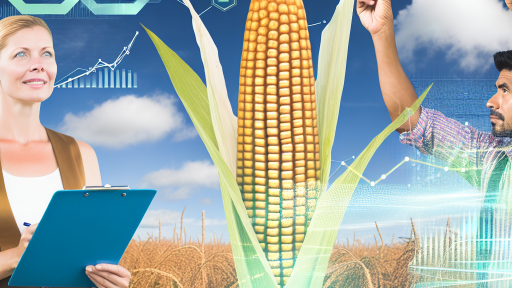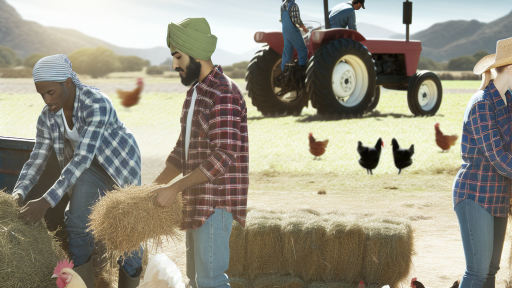Understanding Your Target Audience
Identifying Customer Needs
Recognizing customer needs is vital for modern farmers.
Surveys and interviews provide deep insights into preferences.
Farmers should actively seek feedback from their customer base.
Focus groups can reveal emerging trends and desires.
Assessing Customer Preferences
Farmers must analyze purchasing behaviors to understand preferences.
Loyalty programs can highlight what products resonate with customers.
Utilizing social media analytics helps gauge customer sentiment.
Engaging with customers fosters a stronger relationship.
Segmenting Your Audience
Segmentation allows farmers to target specific customer groups.
Demographics like age, location, and income play a role.
Understanding psychographics reveals customers’ values and lifestyles.
This targeted approach enhances marketing effectiveness.
Building a Customer Profile
A customer profile consolidates data for better understanding.
Farmers should include relevant details such as buying habits.
This profile helps in tailoring products and services.
Transform Your Agribusiness
Unlock your farm's potential with expert advice tailored to your needs. Get actionable steps that drive real results.
Get StartedContinuous updates to the profile reflect changing preferences.
Building a Unique Value Proposition
Understanding Your Audience
Knowing your target customers is essential for differentiation.
Identify their needs, preferences, and pain points.
Conduct surveys and gather feedback regularly.
Engage with customers through social media platforms.
This connection builds trust and loyalty over time.
Highlighting Unique Features
Emphasize what sets your farm apart from competitors.
Offer organic produce, sustainable practices, or artisanal products.
For example, Green Fields Farm promotes its pesticide-free vegetables.
Additionally, Eco Valley Farms uses advanced water conservation techniques.
These unique features attract customers seeking differentiated options.
Crafting Your Brand Story
Your brand story communicates your values and vision.
Share the history of your farm and its mission.
Incorporate anecdotes about challenges overcome in farming.
For instance, Sunny Acres Farm can highlight its transition to organic methods.
A compelling story resonates emotionally with consumers.
Establishing Strong Visual Identity
A strong visual identity enhances brand recognition.
Choose colors, fonts, and logos that reflect your brand personality.
For example, Rustic Roots might use earthy tones and a vintage font.
Ensure that your branding is consistent across all platforms.
This consistency helps reinforce your unique value proposition.
Leveraging Online Presence
Utilize digital marketing to reach a wider audience.
Create a user-friendly website showcasing your products.
Incorporate engaging content like blogs or recipes featuring your produce.
Showcase Your Farming Business
Publish your professional farming services profile on our blog for a one-time fee of $200 and reach a dedicated audience of farmers and agribusiness owners.
Publish Your ProfileAdditionally, use social media to connect with customers directly.
Share behind-the-scenes content to humanize your brand.
Leveraging Social Media Platforms
Engaging with Customers
Modern farmers must utilize social media to connect with their customers.
Social media offers a platform for direct communication.
Engagement helps build trust and loyalty among consumers.
Visual Storytelling Approach
Visual storytelling captivates audiences in a unique way.
Farmers can share images and videos of their operations.
This approach creates an emotional connection with viewers.
Creating Compelling Content
Compelling content showcases the farm’s story and values.
Farmers should highlight their sustainability practices.
Moreover, they can share the challenges and triumphs of farming life.
This authenticity resonates with consumers.
Utilizing Different Media Formats
Farmers can employ various media formats to engage their audience.
Photo albums, short videos, and live streams are effective tools.
For example, a live Q&A session can answer consumer questions directly.
Building a Community Online
Social media serves as a hub for building a community around the brand.
Farmers should encourage feedback and interaction from followers.
This participation fosters a sense of belonging and connection.
Consistent Posting and Engagement
Consistency in posting maintains audience interest.
Farmers need a content calendar for consistent engagement.
Moreover, responding to comments and messages shows that they value their followers.
Learn More: Utilizing Video Marketing in Agribusiness Branding
Creating a Cohesive Brand Identity
Importance of a Strong Brand
A strong brand identity is crucial for modern farmers.
It differentiates products in crowded markets.
Furthermore, it builds customer trust and loyalty.
Designing Logos
Your logo is the visual representation of your brand.
It should communicate your farm’s values and mission.
Consider using simple colors and shapes to enhance recognition.
A well-designed logo can attract customers and create memorability.
In addition, test your logo in various sizes for clarity.
Creating Engaging Packaging
Packaging acts as a direct connection with consumers.
It should reflect your brand’s personality and quality.
Utilize eco-friendly materials to appeal to environmentally conscious buyers.
Moreover, include essential information about your products on the packaging.
Make sure to incorporate attractive designs that stand out.
Developing Marketing Materials
Marketing materials help convey your brand message.
These include brochures, flyers, and business cards.
Consistency in design across all materials is vital.
Utilize your logo, color scheme, and font to maintain this consistency.
Furthermore, share compelling stories about your farming practices.
Showcase Your Farming Business
Publish your professional farming services profile on our blog for a one-time fee of $200 and reach a dedicated audience of farmers and agribusiness owners.
Publish Your ProfileThis storytelling will create an emotional connection with consumers.
Leveraging Social Media
Social media platforms are essential for modern branding.
Share updates on your farming practices and products regularly.
Engage with your audience to foster a community around your brand.
Utilize visuals, such as photos and videos, to enhance engagement.
Ultimately, build your brand story through authentic interactions.
Uncover the Details: Understanding Current Farming Market Trends
Utilizing Email Marketing: Strategies for Cultivating Customer Loyalty and Retention
Building an Email List
Start by creating a dedicated signup form on your website.
Use social media channels to promote your email list effectively.
Additionally, offer incentives such as discounts or exclusive content.
Ensure that your signup process is simple and user-friendly.
Cultivating Engagement Through Relevant Content
Provide valuable content tailored to your audience’s interests.
Include farming tips, seasonal updates, and product news in your newsletters.
Moreover, share customer stories to build community and trust.
Encourage feedback to foster interaction and enhance relationships.
Segmenting Your Audience
Utilize segmentation to send targeted messages to specific groups.
Group customers based on purchase behavior, interests, or engagement levels.
This allows for more personalized communication that resonates with recipients.
Creating Compelling Subject Lines
Craft subject lines that grab attention and encourage opens.
Keep them concise and relevant to the content of the email.
Utilize questions or action-oriented phrases to pique curiosity.
Analyzing and Refining Campaigns
Monitor key metrics such as open rates and click-through rates.
Use A/B testing to determine which elements perform best.
Adjust your strategies based on results for continuous improvement.
Encouraging Customer Loyalty
Implement loyalty programs that reward repeat customers.
Highlight special offers and promotions exclusively for email subscribers.
Recognize important moments, such as anniversaries or birthdays, with personalized messages.
Uncover the Details: Regional Market Insights for Successful Farming

Implementing Sustainable Practices
Understanding Eco-Friendly Branding
Eco-friendly branding emphasizes sustainable farming practices.
This approach appeals to environmentally conscious consumers.
Moreover, it enhances the credibility of your farm.
Demonstrating Commitment to Sustainability
Begin by sharing your sustainable practices openly.
Use social media platforms to showcase your efforts.
Share photos and videos of your farm’s eco-friendly initiatives.
For example, highlight your use of renewable energy sources.
Additionally, describe your organic farming methods.
Engaging the Community
Involve your community in your sustainable practices.
Hold workshops to educate others about eco-friendly farming.
Collaborate with local organizations focused on environmental conservation.
Furthermore, create partnerships with local eco-centric businesses.
Showcase Your Farming Business
Publish your professional farming services profile on our blog for a one-time fee of $200 and reach a dedicated audience of farmers and agribusiness owners.
Publish Your ProfileLeveraging Certifications and Labels
Obtain relevant certifications for your farm.
For instance, consider organic or sustainable agriculture labels.
These certifications validate your commitment to eco-friendliness.
Display these labels prominently on your products.
Creating an Online Presence
Develop a user-friendly website for your farm.
Feature sections that outline your sustainable practices.
Additionally, post regular updates about your eco-initiatives.
Utilize blogs to share insights on sustainable agriculture.
Feedback and Improvement
Encourage feedback from your customers and community.
Use surveys or social media polls to gather opinions.
This feedback can help you improve your sustainable practices.
Moreover, it shows customers that you value their input.
Monitoring and Measuring Impact
Regularly assess the impact of your sustainable practices.
Track metrics such as reduced waste and energy consumption.
This data will inform future improvements in your strategies.
Additionally, share these results with your audience.
You Might Also Like: Market Forecasts: Planning Your Farm’s Future
Collaborating with Local Businesses
Importance of Building Partnerships
Collaborating with local businesses is crucial for modern farmers.
These partnerships enhance brand visibility and credibility.
Moreover, they foster community support and loyalty.
Farmers can reach new customer bases through collaboration.
Identifying Potential Partners
First, identify local businesses that align with your values.
Consider shops, restaurants, and farmers’ markets.
Next, think about suppliers and distributors in your area.
Make a list of potential partners and research their offerings.
Best choices will complement your products and enhance customer experiences.
Creating Win-Win Situations
Design collaborations benefiting both parties involved.
For instance, feature local produce in restaurant menus.
Offer seasonal produce baskets to local grocers.
Collaborative events can draw customers from both businesses.
Marketing efforts can be shared to maximize exposure.
Promoting Collaborative Efforts
Promotion is key to the success of these partnerships.
Utilize social media to announce collaborations.
Engage audiences with joint promotions or events.
Consider creating unique packaging highlighting your partnership.
Collaborative storytelling can engage your community effectively.
Feedback and Improvement
Once your partnerships are established, gather feedback.
Assess what works well and what needs improvement.
Regular communication is crucial for sustained partnerships.
Adapt strategies based on customer responses and sales data.
Showcase Your Farming Business
Publish your professional farming services profile on our blog for a one-time fee of $200 and reach a dedicated audience of farmers and agribusiness owners.
Publish Your ProfileStrengthen ties with partners by sharing successes.
Monitoring and Adapting Your Brand Strategy
The Importance of Data Analytics
Data analytics enables effective brand monitoring.
It provides insights into consumer behavior and preferences.
Understanding these patterns aids in refining branding strategies.
Moreover, it helps identify strengths and weaknesses of your brand.
Choosing the Right Analytics Tools
Various analytics tools are available for modern farmers.
Google Analytics offers insights into website traffic and engagement.
Social media analytics tools help track brand interactions on platforms.
Additionally, customer relationship management (CRM) systems provide valuable sales data.
Setting Key Performance Indicators
Establishing key performance indicators (KPIs) is crucial.
KPIs should align with your branding objectives.
Consider metrics like brand awareness, customer loyalty, and conversion rates.
This will provide a clear framework for measuring success.
Collecting and Analyzing Data
Regularly collect data from multiple sources.
Analyze trends over time to observe changes in consumer behavior.
In-depth analysis can uncover valuable insights to adapt strategies.
Utilize both qualitative and quantitative data for a comprehensive view.
Implementing Changes Based on Insights
Use insights gathered from data analytics to make informed decisions.
Adjust your branding messages or promotional strategies as needed.
Furthermore, be prepared to pivot your approach based on market trends.
Flexibility is key to staying relevant in a competitive market.
Monitoring Progress and Re-evaluation
Continuously monitor the impact of changes on your brand strategy.
Review your KPIs regularly to ensure alignment with objectives.
Re-evaluate your branding strategies based on the latest data.
Remember, branding is an ongoing process that requires constant adaptation.




